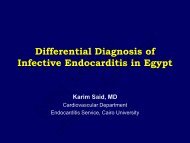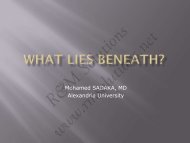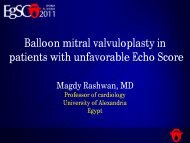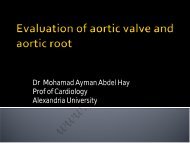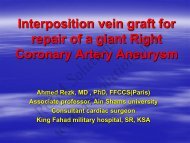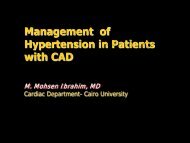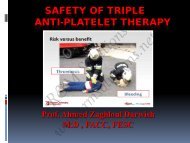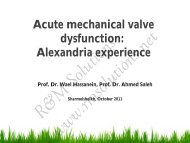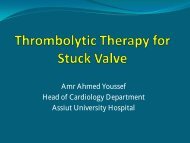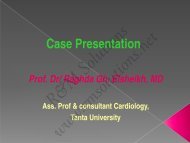ESC Guidelines of Myocardial Revascularization ... - cardioegypt2011
ESC Guidelines of Myocardial Revascularization ... - cardioegypt2011
ESC Guidelines of Myocardial Revascularization ... - cardioegypt2011
- No tags were found...
Create successful ePaper yourself
Turn your PDF publications into a flip-book with our unique Google optimized e-Paper software.
I. <strong>Revascularization</strong> in Stable CADR&M Solutionswww.rmsolutions.net
Evidence Bases For Method <strong>of</strong> Revasularizationin Stable CAD• The COURAGE RCT: (2287 Pt.)- Compared OMT alone Vs OMT + PCI at 4.6Y,- No significant difference in death, MI, stroke or UA.- However only 30% have 3-v disease, 31% had proximalLAD,- LM was excluded & most had normal LV function• CABGE Vs OMT : 7 RCT- CABG is better severe symptoms, +ve stress tests, &with impaired LV functionR&M Solutionswww.rmsolutions.net
Evidence Bases For Method <strong>of</strong> Revasularizationin Stable CAD• Multivessel Disease : >15 RCT• MASS II (611 pt. FU 5Y) compared OMT Vs PCI Vs CABG ;- End point ( mortality, MI, or angina requiring revascularization)was lower in PCI Vs OMT & lower in CABG Vs PCI(p< .003)• SYNTAX : (RCT 1800 Pts & Registery 1077 Pts)• Compared PCI vs CABGE in severe CAD including LM &/ or3-VD• At 1 st & 2 nd year results indicated that CABG remainsthe standard <strong>of</strong> care for patients with 3-V or LM CADR&M Solutionswww.rmsolutions.net
Evidence Bases For Method <strong>of</strong> Revasularizationin Stable CAD• SYNTAX• However PCI was found equal or even superior for lowerseverity <strong>of</strong> LM after 2Y results• In subgroup analysis <strong>of</strong> SYNTAX after 1Y CABG is favoredfor prevention <strong>of</strong> repeat revascularization but athigher risk <strong>of</strong> cerebrovascular accidents• It provides a score terciles after the 1 st year resultsaccording to the anatomical complexity <strong>of</strong> the coronarylesions & this score helps in determining the method <strong>of</strong>revascularizationR&M Solutionswww.rmsolutions.net
Definition <strong>of</strong> the Coronary Tree1-3Each=01-4Each=1SegmentsEach16=0.562.53.51.5 12-1551.50.5R&M SolutionsEach=11Each12=1Each14=2.5www.rmsolutions.net0.5110.50.5Thesame
Evidence Bases For Method <strong>of</strong> Revasularizationin Stable CAD* Score 0 – 22 MACE in CABG Vs PCI (P= 0.19) favoring PCI* Score 23 – 32 MACE in CABG Vs PCI (P= 0.54) favoring PCI* Score > 33 MACE in CABG Vs PCI (P< 0.08) favoring CABG- The three-year result s made it crystal clear that patients atintermediate risk (SYNTAX score 23-32) are better <strong>of</strong>f withopen-heart surgery, as are those at highest riskR&M Solutionswww.rmsolutions.net
Evidence Bases For Method <strong>of</strong> Revasularizationin Stable CAD• Last week in Lisbon, Portugal 4-year data from theSYNTAX trial show that mortality is significantly higher inthe PCI Vs CABG, as was MI, and the excess rate <strong>of</strong>strokes initially observed in the CABG arm has now leveledout• But the surrogate safety end point <strong>of</strong> death/stroke/MI is notsignificantly different between the two arms <strong>of</strong> the studyR&M Solutions• Reported Dr Patrick Serruys in EACTS 2011 AnnualMeeting last weekwww.rmsolutions.net
<strong>Guidelines</strong> For <strong>Revascularization</strong>in Stable CADR&M Solutionswww.rmsolutions.net
R&M Solutionswww.rmsolutions.net
I. <strong>Guidelines</strong> For <strong>Revascularization</strong> inThe main indications are :Stable CADI. On Symptom Ground :1. Persistence <strong>of</strong> limiting angina or angina equivalent (dyspnea;fatigue) despite Optimal Medical Therapy (OMT) (I A)2. Dyspnea/ CHF & > 10% LV ischemia /viability supplied by (II a B )+Stenosis > 50%3 . No limiting symptom with OMT (III C)R&M Solutionswww.rmsolutions.net
I. <strong>Guidelines</strong> For <strong>Revascularization</strong> inStable CADII. On Prognostic Ground :- The burden <strong>of</strong> ischemia is more important thansymptoms in determining prognosis , ie death, MI & ACS1. LM >50% + documented ischemia (I A)2. Proximal LAD > 50% + documented ischemia (I A)3. 2VD or 3VD + LV Dysfunction + ischemia (I B)4. Proven > 10% ischemic area (I B)R&M Solutions5. Single remaining patent vessel > 50% stenosis + ischemia (I C)6. 1-VD without proximal LAD & without > 10% ischemia (III A)www.rmsolutions.net
• <strong>Guidelines</strong> for CABGE Vs PCI inStable CADSuitable for Both ProceduresR&M Solutionswww.rmsolutions.net
R&M Solutionswww.rmsolutions.net
Indications For CABG vs PCI For LesionsSuitable For BothCABG1. 1-VD or 2-VD ,non-proximal LAD IIb C I C2. 1-VD or 2-VD , + proximal LAD I A II a B3. 3-VD simple lesions , Syntax < 22 I A II a B4. 3-VD complex lesions , Syntax >22 I A III A5. LM isolated Ostium/shaft I A II a B6. LM isolated distal bifurication I A II b B7. LM + 2 or 3VD Syntax < 32 I A II b B8. LM + 2 or 3VD Syntax > 33 I A III BR&M Solutionswww.rmsolutions.netPCI
II. <strong>Revascularization</strong> in Acute CoronarySyndromea) UA/NSTEMIR&M Solutionswww.rmsolutions.net
IIa. <strong>Revascularization</strong> in NSTEMI (ACS)• It is the largest & the most heterogenus groupundergoing PC• Its mortality equals that <strong>of</strong> STEMI‣ Risk Stratification : GRACE Risk Score1. In high risk Score > 140 urgent angiography within 24h- High risk includes persistent chest pain, marked ↓ ST , hemodynamic, or electrical instability & ↑ TroponinR&M Solutions2. In low risk invasive procedure is <strong>of</strong> little benefit ormay be hazardouswww.rmsolutions.net
IIa. <strong>Revascularization</strong> in NSTEMI (ACS)• FRISC II, ICTUS , & RITA III confirmed the benefit <strong>of</strong>early invasive approach in high risk patients• The procedure is CA and Ad-hoc PCI or CABG• Culprit vessel should be intervene first by PCI if possible& then decision is similar to that in stable CAD• FFR is used for borderline MVD lesions• Unlike PCI, CABG is done after several days <strong>of</strong> medicalstability R&M Solutionswww.rmsolutions.net
<strong>Guidelines</strong> for <strong>Revascularization</strong>in NSTEMI (ACS)R&M Solutionswww.rmsolutions.net
R&M Solutionswww.rmsolutions.net
<strong>Guidelines</strong> For <strong>Revascularization</strong> inNSTEMI- Invasive in GRACE Score > 140, in very high risk patientsin 2 to < 24h (I A)- Late invasive < 72h in GRACE Score < 140, but withrecurrent symptoms or stress-induced ischemia ( I A)- In refractory angina, HF, arrhythmia or hemodynamicinstability emergency CA < 2h (IIa C)- Invasive is not performed in low- risk or in at high riskR&M Solutionsfor intervention (III A)www.rmsolutions.net
II. <strong>Revascularization</strong> in AcuteCoronary Syndromeb) STEMIR&M Solutionswww.rmsolutions.net
IIb. <strong>Revascularization</strong> <strong>of</strong> STEMIReperfusion Strategies :I. 1 ry PCI : is the PCI in STEMI without previous fibrinolysis- RCTs & Metaanalysis reported that 1 ry PCI 6 -12 h after theonset <strong>of</strong> chest pain is better than fibrinolysis in outcomes& mortalityII. Fibrinolysis : Despite its disadvantages it remains as pre-hospital treatment, and as alternative for PCIR&M Solutionswww.rmsolutions.net
IIb. <strong>Revascularization</strong> <strong>of</strong> STEMIIII. Facilitated PCI : Elective use <strong>of</strong> reduced or normal dose<strong>of</strong> fibrinolysis + GP IIb/ IIIa inhibitors + PCI 90 -120 minafter first medical contact- It has no significant advantage over 1 ry PCIIV. Delayed PCI : It includes- Rescue PCI after failed fibrinolysis- PCI after successful fibrinolysisR&M Solutionswww.rmsolutions.net
IIb. <strong>Revascularization</strong> <strong>of</strong> STEMIV. Emergency CABG : It is considered in failed PCI, in verylarge MI & surgical revascularization is completed in 3 -4 hbefore this area becomes necroticVI. Urgent CABG : There is inverse relationship betweenmortality & time elapsed since STEMI; if possible wait for3 -7dR&M Solutionswww.rmsolutions.net
IIb.<strong>Guidelines</strong> for <strong>Revascularization</strong>in STEMI (ACS)R&M Solutionswww.rmsolutions.net
R&M Solutionswww.rmsolutions.net
IIb.<strong>Guidelines</strong> For <strong>Revascularization</strong> inSTEMI- With exception <strong>of</strong> cardiogenic shock revascularizationshould be directed to culprit vessel only (IIa B)I. 1 ry PCI : is indicated in- Chest pain < 12h + ↑ST or previous undocumented LBBBas soon as possible 12h + persistent ↑ST or LBBB as soon aspossible (IIa C)- History <strong>of</strong> chest pain > 12h < 24h + persistent ↑ST orLBBB as soon as possible (IIb B)R&M Solutionswww.rmsolutions.net
IIb.<strong>Guidelines</strong> For <strong>Revascularization</strong> inII. PCI After Fibrinolysis :STEMI- Routine urgent PCI after successful fibrinolysis within 24hto reduce delay for patients with no perfusion (I A)- Rescue PCI as soon as possible (IIa A)III. Elective PCI/ CABG :- It is indicated after documentation <strong>of</strong> angina / +veprovactive test (I B)- It is not recommended for those with fully developedQ-wave MI, no angina or evidence <strong>of</strong> viability in infarctterritory (III B)R&M Solutionswww.rmsolutions.net
II. <strong>Revascularization</strong> in AcuteCoronary SyndromeC. <strong>Guidelines</strong> in Cardiogenic Shock& Acute HFR&M Solutionswww.rmsolutions.net
R&M Solutionswww.rmsolutions.net
IIc. <strong>Guidelines</strong> For <strong>Revascularization</strong> in CardiogenicShock & Acute HF- In NSTE-ACS or STEMI & unstable hemodynamics immediaterevascularization (I A )- Immediate reperfusion for acute HF + ongoing ischemia (I B)- No time limit between onset <strong>of</strong> symptom & intervention- Emergency revascularization <strong>of</strong> all critically narrowed arteries(I B )R&M Solutions- IABP in cardiogenic shock & mechanical complications (I C)www.rmsolutions.net
Mechanical Complications <strong>of</strong> AMI- In acute HF TTE to detect, MR, VSD, cardiac rupture &tamponade- In all with medical treatment mortality is 100%- Tamponade is treated by pericardiocentesis at bedside- In VSD surgery should be performed as soon as possible;closure devices is not supportedR&M Solutions- Acute MR should be treated promptly with surgerywww.rmsolutions.net
Conclusion I• In Stable multi-V CAD confirm ischemia bya) Non-invasive stress imaging orb) Invasive FFR• In Stable CAD revascularization is indicated forpersistent limiting symptoms or proven ischemicburden > 10%R&M Solutionswww.rmsolutions.net
Conclusion II• Method <strong>of</strong> revascularization whether PCI orCABG depends on the recommended <strong>Guidelines</strong>• <strong>Revascularization</strong> in NSTEMI (ACS) depends onthe Risk Stratification• <strong>Revascularization</strong> in STEMI (ACS) depends onaccessibility & feasibility <strong>of</strong> 1 ry PCI center working24h/7days & expert operators.R&M Solutionswww.rmsolutions.net
Conclusion III• <strong>Revascularization</strong> in STEMI (ACS) should intervenein culprit artery only• <strong>Revascularization</strong> in Cardiogenic Shock (ACS)obligates full revascularization & no limit timefor delayness• Mechanical complications <strong>of</strong> AMI withhemodynamic instability obligates surgery assoon as possibleR&M Solutionswww.rmsolutions.net
R&M Solutionswww.rmsolutions.net




